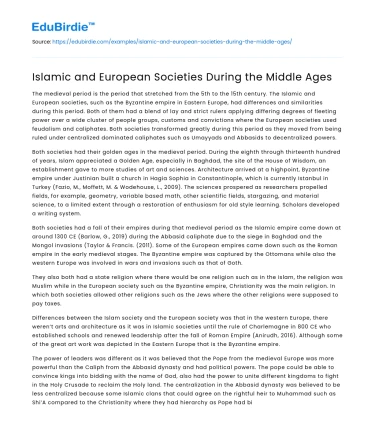The medieval period is the period that stretched from the 5th to the 15th century. The Islamic and European societies, such as the Byzantine empire in Eastern Europe, had differences and similarities during this period. Both of them had a blend of lay and strict rulers applying differing degrees of fleeting power over a wide cluster of people groups, customs and convictions where the European societies used feudalism and caliphates. Both societies transformed greatly during this period as they moved from being ruled under centralized dominated caliphates such as Umayyads and Abbasids to decentralized powers.
Both societies had their golden ages in the medieval period. During the eighth through thirteenth hundred of years, Islam appreciated a Golden Age, especially in Baghdad, the site of the House of Wisdom, an establishment gave to more studies of art and sciences. Architecture arrived at a highpoint, Byzantine empire under Justinian built a church in Hagia Sophia in Constantinople, which is currently Istanbul in Turkey (Fazio, M., Moffett, M. & Wodehouse, L., 2009). The sciences prospered as researchers propelled fields, for example, geometry, variable based math, other scientific fields, stargazing, and material science, to a limited extent through a restoration of enthusiasm for old style learning. Scholars developed a writing system.
Save your time!
We can take care of your essay
- Proper editing and formatting
- Free revision, title page, and bibliography
- Flexible prices and money-back guarantee
Both societies had a fall of their empires during that medieval period as the Islamic empire came down at around 1300 CE (Barlow, G., 2019) during the Abbasid caliphate due to the siege in Baghdad and the Mongol invasions (Taylor & Francis. (2011). Some of the European empires came down such as the Roman empire in the early medieval stages. The Byzantine empire was captured by the Ottomans while also the western Europe was involved in wars and invasions such as that of Goth.
They also both had a state religion where there would be one religion such as in the Islam, the religion was Muslim while in the European society such as the Byzantine empire, Christianity was the main religion. In which both societies allowed other religions such as the Jews where the other religions were supposed to pay taxes.
Differences between the Islam society and the European society was that in the western Europe, there weren’t arts and architecture as it was in Islamic societies until the rule of Charlemagne in 800 CE who established schools and renewed leadership after the fall of Roman Empire (Anirudh, 2016). Although some of the great art work was depicted in the Eastern Europe that is the Byzantine empire.
The power of leaders was different as it was believed that the Pope from the medieval Europe was more powerful than the Caliph from the Abbasid dynasty and had political powers. The pope could be able to convince kings into bidding with the name of God, also had the power to unite different kingdoms to fight in the Holy Crusade to reclaim the Holy land. The centralization in the Abbasid dynasty was believed to be less centralized because some Islamic clans that could agree on the rightful heir to Muhammad such as Shi’A compared to the Christianity where they had hierarchy as Pope had bishops that plead allegiance to Pope and who led the regional churches.
Christianity was less restrictive towards women than the Islam society. Although Christians did not treat women that well but they were far much better than the Islam society. In the Medieval Europe, women had the chance of being taught by the Catholic church thus being able to become a nun to serve the church whilst in the Abbasid society, women weren’t allowed to lead any religious activities and parents had mostly think and make decisions on behalf of their daughters thus, women never had the chance to make an alternative to marriage. Women in the Medieval Europe had a voice in the politics whereby they were able to rule as regent if their sons were to young to rule. They also gave political views to their husbands unlike in the Abbasid dynasty.
The Abbasid dynasty had more intellectual achievement than the European society. The Abbasid dynasty devolved into mathematics creating trigonometry such as tangent, cosine and sine (Brewis, B.T., 2019). Also, they invented the astronomical tables. They also had one of the biggest hospitals in Cairo. They also ventured more into literature than the European society where by they had literatures that were used mainly in the west such as the Rubáiyát that was written by Omar Khayyám (Yohannan, John D., 1977).






 Stuck on your essay?
Stuck on your essay?

